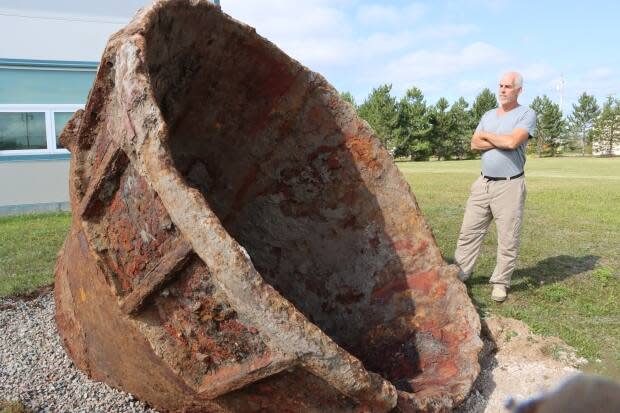Relic from Sydney's steelmaking past to once again 'light up the sky'

Sydney's industrial past is back in the limelight with the discovery of a relic from its steelmaking heyday.
A roughly eight-tonne metal ladle unearthed last summer by a construction crew at Harbourside Commercial Park is now being transformed into a public art display.
The massive metal cauldron sits outside the new Sydney headquarters of data storage firm, 45Drives.
"Time and corrosion have really taken a toll on it," said Doug Milburn, the company's vice-president and co-founder. "I bet that's probably some old slag or something that was inside there."
Milburn said the cinder ladle would have been loaded onto a railcar and used to transport slag, a waste product of the steelmaking process.
"You'd have this super hot, over 1,000 degrees, glowing liquid rock coming out of there," he said.
"You take the slag, go to the furnaces and dump it up to the slag heaps and, you know, light up the sky with the glow. So that's what this thing would have been used for."
Milburn said Sydney's steelmaking was innovative and deeply ingrained in the social fabric of its neighbouring communities, with steel having been made on the island for more than a century.
After a series of financial struggles, the Sydney steel plant finally closed in 2001.
Art project underway
Glenn Stevens, who had two grandparents once working at the mill, is the special projects manager tasked with moving the art installation along.
His paternal grandfather, Benjamin Stevens, was killed in an accident at the plant at 44. After his death, Stevens's grandmother started working there to help feed her nine children.
Stevens said he's trying to ensure the ladle will be visible to motorists driving by at night.
"The goal will be at nighttime when you drive by and look over at that ladle, it looks like it's pouring molten steel or slag," he said.
"If I pull this off, it should look spectacular."
Stevens said it's hoped the project pays tribute to the people who helped make a culturally rich and vibrant community.
"There's no real museum for the steel plant," he said. "So when you come across a piece like the ladle, I think it's important to use that as a tribute to the people who worked at the plant."
Stevens is hoping to have the project finished by mid-September, so it can be featured in Sydney's contemporary arts festival, Lumière.
MORE TOP STORIES

